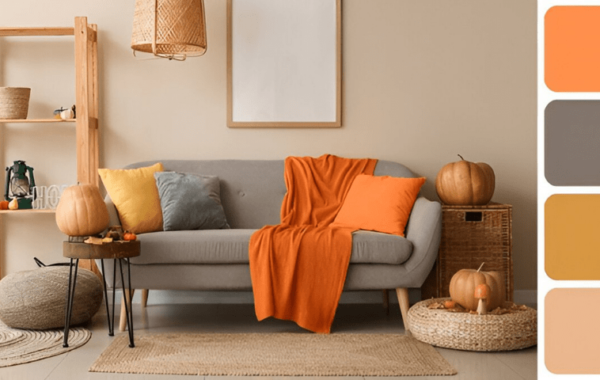
The Rise of Industrial Chic: Blending the Past with the Present in Contemporary Interiors
Introduction :
Within the dynamic realm of interior design, trends emerge and go. Still, some styles stand the test of time and continue to captivate enthusiasts. One such style that has witnessed a resurgence in recent years is industrial chic. Rooted in the utilitarian aesthetics of factories and warehouses, industrial style embraces raw, unfinished elements. It transforms them into stylish, sophisticated interiors. This article delves into the reasons behind the popularity of industrial design elements in contemporary spaces. It provides insights on how to incorporate them into your own home effectively.
The Root of industrial Chic
The industrial chic style draws inspiration from the bygone era of the Industrial Revolution when factories and warehouses served as the epicenter of mass production. The aesthetic elements of these spaces—exposed brick walls, steel beams, and concrete floors—have become iconic symbols of a time when functionality and efficiency took precedence. In the 21st century, designers and homeowners alike have embraced industrial spaces’ raw and unpolished charm, giving birth to the industrial chic movement.
Why Industrial Chic?
The appeal of Industrial chic or industrial style lies in its ability to marry the past with the present, creating a unique blend of nostalgia and contemporary flair. The style celebrates imperfections, turning what was once considered unsightly into a thing of beauty. Using materials like reclaimed wood, aged metals, and distressed finishes adds character and warmth to a space, creating an inviting atmosphere that contrasts with the sleekness of modern design.
Incorporating Industrial Elements
While the allure of Industrial Chic is undeniable, effectively incorporating industrial elements into your home requires a thoughtful approach. Here are some key considerations to keep in mind:
Balance is Key:
Achieving the right balance between industrial elements and other design styles is crucial. More industrial influence can make a space feel warm and welcoming, while more may dilute the desired aesthetic. Strike a balance by integrating industrial elements selectively and pairing them with softer textures and furnishings.
Exposed Structures:
Embrace the essence of industrial design by leaving structural elements exposed. Exposed brick walls, steel beams, and ductwork can add a raw and authentic touch to your interiors. If your home doesn’t have these features naturally, consider faux finishes or textured wallpapers to recreate the look.
Reclaimed Materials:
Incorporating reclaimed materials is a hallmark of Industrial Chic. Seek out salvaged wood, distressed metal, and repurposed furniture to infuse your space with a sense of history. These elements contribute to sustainability and tell a story of the past.
Neutral Palette with Pops of color:
Industrial Chic often relies on a muted color scheme of white, black, and gray tones dominating the scene. However, don’t shy away from adding pops of color to inject vibrancy into the space. Bold accent furniture, vibrant artwork, or lush greenery can complement the industrial backdrop.
Lighting Fixtures:
The proper lighting can elevate the industrial aesthetic. Opt for statement lighting fixtures with an industrial edge—exposed bulbs, metal cages, and pulley systems are prevalent. These fixtures not only provide functional illumination but also serve as striking focal points.
Furniture Selection:
When selecting furniture, look for pieces that echo the industrial vibe. Metal-framed chairs, leather sofas, and furniture with clean lines contribute to the overall aesthetic. Mixing softer elements like cushions and throws can create a more comfortable and inviting atmosphere.
Art and Accessories:
Personalize your space with industrial-inspired art and accessories. Vintage signage, industrial-style clocks, and large-scale artwork can enhance the theme. Look for pieces that resonate with the industrial era or incorporate materials like iron, glass, and weathered wood.
Conclusion:
The resurgence of Industrial Chic in contemporary interiors reflects a desire for authenticity, character, and a connection to the past. By seamlessly blending utilitarian aesthetics with modern comforts, this design style offers a timeless and versatile approach to home decor. As you embark on your journey to incorporate industrial elements into your space, remember to strike a balance, embrace the raw beauty of exposed structures, and infuse the warmth of reclaimed materials. With careful consideration and a creative eye, you can effortlessly achieve the captivating allure of Industrial Chic in your home.
Cibi+Simeon designs seamlessly incorporates industrial chic into their smart home designs by blending raw materials like exposed brick, metal, and also reclaimed wood with advanced smart technologies. Their approach emphasizes open floor plans, minimalist aesthetics, and the integration of modern, automated systems, creating living spaces that are both stylish and functional. This fusion of traditional industrial elements with cutting-edge technology results in homes that are not only visually striking but also highly efficient and comfortable.
FAQs
What defines Industrial Chic Design?
Industrial Chic design is characterized by raw, utilitarian aesthetics inspired by factories and warehouses, featuring exposed structures, reclaimed materials, and a balance of textures.
Why has Industrial Chic become Popular?
The style’s ability to blend nostalgia with contemporary flair, celebrating imperfections and incorporating reclaimed materials, appeals to those seeking a unique, authentic home aesthetic.
How can I Incorporate Chic elements at home?
Achieve balance by selectively exposing structural elements, integrating reclaimed materials, embracing a neutral palette with pops of color, and choosing furniture and lighting with an industrial edge.
What materials are synonymous with Industrial Chic?
Industrial Chic often features materials like exposed brick, aged metals, distressed wood, and concrete, adding character and warmth to interiors while telling a story of the past.
Can Industrial Chic be combined with other design styles?
Yes, Industrial Chic can be successfully blended with other styles. The key is finding a harmonious balance, selectively integrating industrial elements, and pairing them with complementary textures and furnishings.


